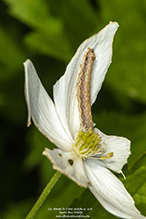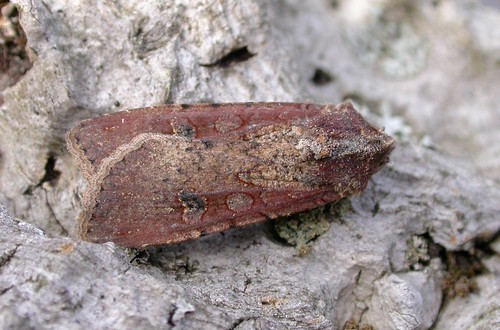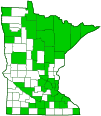variegated cutworm moth
(Peridroma saucia)
Conservation • Description • Habitat • Ecology • Distribution • Taxonomy
|
||||||||
| Hodges # | 10915 |
|||||||
Conservation Status |
||||||||
| IUCN Red List | not listed |
|||||||
| NatureServe | N5 - Secure SNR - Unranked |
|||||||
| Minnesota | not listed |
|||||||
Description |
||
Variegated cutworm moth is an exotic, medium-sized, migratory moth. It occurs in Europe, Asia, North Africa, North America, and South America. Its origin is not certain, but it may be Europe, where it was first recorded in 1790. It is thought to be invasive in the United States. It cannot survive Minnesota’s cold winters, but it recolonizes the state each spring. Adults are active from June to October in agricultural areas and in disturbed habitats, but rarely in natural areas. The larvae feed on the foliage of more than 125 species of plants. Variegated cutworm moth is a major economic pest of greenhouses and agricultural crops, including vegetables, fruit trees, alfalfa, and grasses. The larvae cut the stem of a plant at ground level, thus killing the plant. An infestation can decimate an entire garden or field in just days. Adults are 1″ (25 mm) in length and have a 1¾″ to 2¼″ (45 to 56 mm) wingspan. Moth size is sometimes given in terms of forewing length, which in this case is ⅝″ to 1″ (15 to 25 mm). The head is dark brown. The antennae on the female are slender and thread-like. On the male the antennae are slightly swollen and bead-like, with a tuft of short hairs on each side of each segment. The eyes are hairless. The finger-like sensory mouthparts (labial palps) have three segments. The second segment has a projecting tuft of long scales at the end on the underside. The third segment is about two times as long as wide, and it has a similar but shorter tuft at the end. The thorax is dark brown with a raised crest in the middle (middorsal). The crest is formed from hair-like scales and slightly spatula-shaped scales with pale tips, giving the crest a frosted appearance. The forewings are long and moderately narrow. The color is variable, from pale yellowish brown to dark reddish brown. They are usually heavily speckled with black scales, giving the wings a burnt orange or yellow appearance. The subterminal area is usually darker. The basal, antemedial (AM), and postmedial (PM) lines are black, jagged, and double. They are usually faint and sometimes obscured by the black speckling, but they are always represented by a double black spot on the wing’s leading edge (costal margin). The median line is represented by a single black spot on the costal margin. The circular spot (orbicular spot) in the upper median area near the AM line is large, oval, and usually pale. The hindwings are pearly gray with dark shading on the margins and dark veins. The fringe is dark at the base, white on the outer half. On the front legs, the fourth leg segment (tibia) has a complete row of 5 to 7 spine-like hairs (setae) on the inner margin and one seta at the tip on the outer margin. The caterpillar is stout, smooth, fleshy, and less than 1¾″ (4.5 cm) in length. The color is variable, ranging from brown to gray and light to dark. The white to orange stripe on the upper middle (middorsal) becomes small spots at the end of abdominal segments 1 through 4 (A1 to A4). There is a pale yellowish or orangish rump patch on A8 preceded by an irregular black patch. On each side of the body, there is a pale stripe below the breathing pores (spiracles). It often has shades of orange and is often poorly differentiated. The top of the head has two black stripes separated by a black spot. Taken together, it appears like the letter M. |
||
Size |
||
Total length: 1″ (25 mm) Wingspan: 1¾″ to 2¼″ (45 to 56 mm) |
||
Similar Species |
||
Habitat |
||
Agricultural and disturbed areas |
||
Ecology |
||
Season |
||
June to October. |
||
Behavior |
||
The larvae feed at night. |
||
Life Cycle |
||
|
||
Larva Food |
||
Plant leaves |
||
Adult Food |
||
Flower nectar |
||
Distribution |
||||
|
Sources |
|||
| 10/25/2023 | ||||
Occurrence |
||||
Common |
||||
Taxonomy |
|||
Order |
Lepidoptera (Butterflies and Moths) | ||
Superfamily |
Noctuoidea (Owlet Moths and Allies) | ||
Family |
Noctuidae (cutworm moths and allies) | ||
Subfamily |
Noctuinae (cutworms and dart moths) | ||
Tribe |
Noctuini | ||
| Subtribe | Agrotina | ||
Genus |
Peridroma | ||
Synonyms |
|||
Agrotis ambrosioides Agrotis angulifera Agrotis brunnea Agrotis cyrnaea Agrotis decolor Agrotis fuscobrunnea Agrotis impacta Agrotis inermis Agrotis intecta Agrotis juncta Agrotis nigrocosta Agrotis ochreacosta Agrotis ochronota Agrotis ortonii Agrotis philippsi Agrotis rufa Agrotis saucia Agrotis tenebricosa Euxoa brunnea Lycophotia ochronota Lycophotia saucia Noctua aequa Noctua majuscula Noctua margaritosa Noctua orophila Noctua polygona Noctua saucia Peridroma ambrosioides Peridroma chilenaria Spaelotis infuscata Spaelotis stictica |
|||
Common Names |
|||
pearly underwing variegated cutworm variegated cutworm moth |
|||
Glossary
Antemedial (AM) line
A thin line separating the basal area and the median area of the forewing of Lepidoptera.
Costal margin
The leading edge of the forewing of insects.
Orbicular spot
A circular spot or outline in the upper median area near the antemedial line on the forewing of many moths.
Palp
Short for pedipalp. A segmented, finger-like process of an arthropod; one is attached to each maxilla and two are attached to the labium. They function as sense organs in spiders and insects, and as weapons in scorpions. Plural: palpi or palps.
Seta
A stiff, hair-like process on the outer surface of an organism. In Lepidoptera: A usually rigid bristle- or hair-like outgrowth used to sense touch. In mosses: The stalk supporting a spore-bearing capsule and supplying it with nutrients. Plural: setae. Adjective: setose.
Spiracle
A small opening on the surface of an insect or arachnid through which it breathes.
Tibia
The fourth segment of an insect leg, after the femur and before the tarsus (foot). The fifth segment of a spider leg or palp. Plural: tibiae.
Visitor Photos |
|||||
Share your photo of this insect. |
|||||
| This button not working for you? Simply email us at info@MinnesotaSeasons.com. Attach one or more photos and, if you like, a caption. |
|||||
Alfredo Colon |
|||||
 |
|||||
MinnesotaSeasons.com Photos |
|||||
|
|||||

Slideshows |
||
| Pearly Underwing, Peridroma saucia Briantspuddle Wildlife & History |
||
 |
||
About
One 10 Oct 2015, on an excellent night with 2 Clifton Nonpareil +; Flounced Rustic. |
||

Visitor Videos |
|||
Share your video of this insect. |
|||
| This button not working for you? Simply email us at info@MinnesotaSeasons.com. Attach a video, a YouTube link, or a cloud storage link. |
|||
Other Videos |
|||
| The Varigated Cutworm or Pearly Underwing Moth Carl Barrentine |
|||
About
Aug 8, 2012 Photographed at Fisher, Minnesota (07 August 2012) |
|||
| generalist cutworms feed on giant knotweed Stacy E |
|||
About
Aug 9, 2020 Peridroma saucia larvae (a widespread generalist cutworm) feed on a sprig of knotweed. Video is taken over 5 minutes (sped up x30). |
|||
| Moth - Variegated Cutworm 1 HQ HD PETE DOVE'S NIAGARA WILDLIFE |
|||
About
Jul 5, 2021 Profile of a Variegated Cutworm Moth. |
|||

Created: 10/25/2023
Last Updated:


